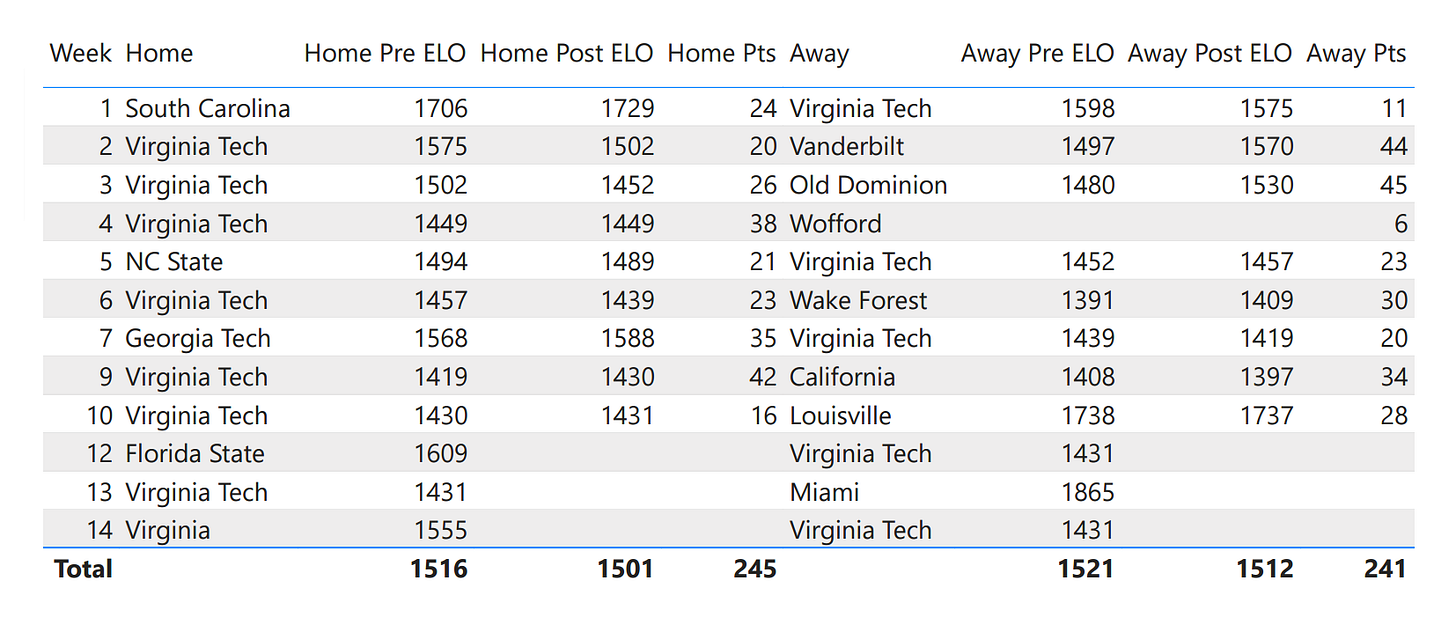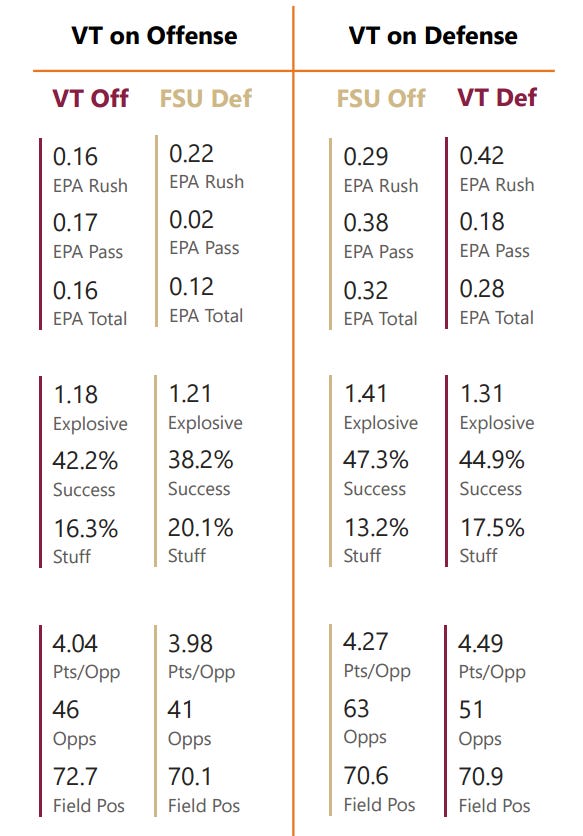Hokies to Face Dr. Jekyll or Mr. Hyde
Virginia Tech will either win by one score or get blown off the field Saturday night
Florida State’s advanced stats align with a strong 7-5 team or perhaps an 8-4 team that is playing a weaker schedule.
To reach 7-5, however, FSU will need to win its final three games, two of which are on the road.
The Seminoles will probably be favored in all three games, but is it really likely that they win all three?
Breaking down their record, the 'Noles are an all-or-nothing sort of team:
One-score games: 0-4
Two touchdown games: 1-1
Three or more touchdown game: 3-0
The line on Saturday night’s game is an even 14.0 points, so that means the Hokies have a 50% chance of winning the game, right?
Actually, yeah, they kinda do.
Framing this matchup in terms of offensive and defensive matchups is a fool’s game.
I promise you, on paper Florida St. entered its games with Stanford and UVA looking stronger in almost every statistical category.
FSU lost both games.
Likewise, did anyone really see Mike Norvell’s team not only upsetting, but dominating Alabama back in week 1?
In order to present as rich a picture as possible, first I’ll tackle the advanced stats, then I’ll break down the two versions of Florida St. that could face Virginia Tech.
The sum of Florida State’s parts
If we throw the 2025 Seminoles in a blender, what comes out, in smoothie form, is a team that should beat Virginia Tech by around 10 points.
In ELO terms, a 1500 rating roughly corresponds to a 6-6 power conference team. Every additional 100 rating points add a win and subtract a loss. So, just looking at ELO, Florida St. is roughly a 7-5 level team, while the Hokies are a 5-7 level team.
Team-level advanced stats tell a similar story - the Seminoles are better in almost every category.
The only advanced stat in the above chart that tilts in the Hokies’ direction is EPA on rushing plays when Virginia Tech has the ball.
Otherwise, the chart screams, “'Noles, comfortably.”
But none of the above numbers represent who the Seminoles are as a football team midway through November.
A host of transfers and a new offense took the first few opponents by surprise (mainly Alabama - the other two were patsies). However, once tape got out showing what this team does and does not do well, the results flip-flopped.
Normalizing results
The out of conference games seem like eons ago for both teams. Florida St. (3-0) was unstoppable, and Virginia Tech was unmovable (0-3).
In conference play, it has been a different story:
Virginia Tech: 2-3, 24.8 ppg scored, 29.6 ppg allowed
Florida State: 1-5, 26.0 ppg scored, 26.5 ppg allowed
Those results are much more even, but Florida State’s scoring is skewed by its win over Wake Forest (42-7). In fact, many of FSU’s one score losses were not as close as the final score made them appear.
With that in mind, here is a break down of the score through three quarters in conference games for each team:
Virginia Tech
at NC State: winning 20-14 (won 23-21)
vs Wake Forest: losing 23-27 (lost 23-30)
at Georgia Tech: losing 14-28 (lost 20-35)
vs California: tied 20-20 (won 42-34 in OT)
vs Louisville: losing 16-21 (lost 16-28)
On average, the Hokies have scored 18.6 ppg in the first three quarters of their ACC games while allowing 22.0 ppg during those same three quarters.
Virginia Tech, -3.4 points through three quarters, tends to fade in the fourth quarter.
It has been a different story with the Seminoles:
Florida State
at Virginia: tied 28-28 (lost 38-46 in OT)
vs Miami: losing 3-28 (lost 22-28)
vs Pittsburgh: winning 24-21 (lost 31-34)
at Stanford: losing 10-20 (lost 13-20)
vs Wake Forest: winning 28-0 (won 42-7)
at Clemson: losing 7-21 (lost 10-24)
In conference play, FSU is scoring 16.7 ppg through the first three quarters and allowing 19.7 ppg.
Like Virginia Tech, Florida St. has, on average, entered the fourth quarter of conference games trailing by a field goal. Unlike the Hokies, the Seminoles have rallied in the fourth quarter of their games.
If we throw out each team’s best result after three quarters, NC State for the Hokies and Wake Forest for the Seminoles, then we find the Hokies trailing on average by 5.8 points entering the fourth quarter and FSU losing by 9.2 points.
All of this is to say that in conference games, both teams’ stats are skewed by the fourth quarter. This period has hurt Tech’s numbers and helped FSU’s.
Virginia Tech was off last week, whereas Florida St. lost a tough game at Clemson.
Unless FSU breaks open the game early, there is a good chance the Hokies will begin the fourth quarter with a lead. At that point, the question will be, can the Hokies hold off a Seminole comeback bid?
Thoughts on the James Franklin situation
Numerous outlets this week have reported that Virginia Tech has met every demand James Franklin has made regarding the possibility of him becoming the next head coach in Blacksburg.
While that appears to be a good thing, it has me rather concerned. The search committee appears content to let the next coach determine the front office structure within the football program, which I think would be a massive mistake.
Franklin knows what has worked for him at Vanderbilt and Penn St. Virginia Tech in 2025 is rather different from both of Franklin’s previous stops.
That the Virginia Tech brass would let Franklin essentially draw the org chart within the program suggests to me that the committee knows neither what is wrong with Tech’s current setup, nor what should be done to fix it.
The savior model of coach appears to be on its way out. Virginia Tech could position itself for lasting success if it structured the front office, scouting, and development parts of the program - the permanent roles - independent of the next coach. The coach really should only be in charge of on-field decision making and its antecedents (i.e., hiring the coaching staff).
Once again, the Hokies appear to be one era behind college football’s leaders.
Will it cost them?
I’m afraid it might.




